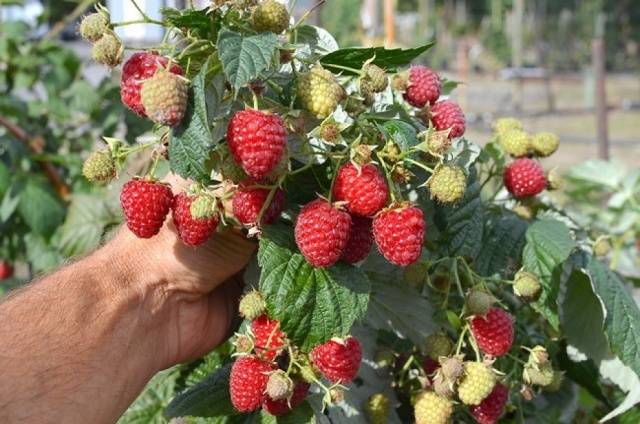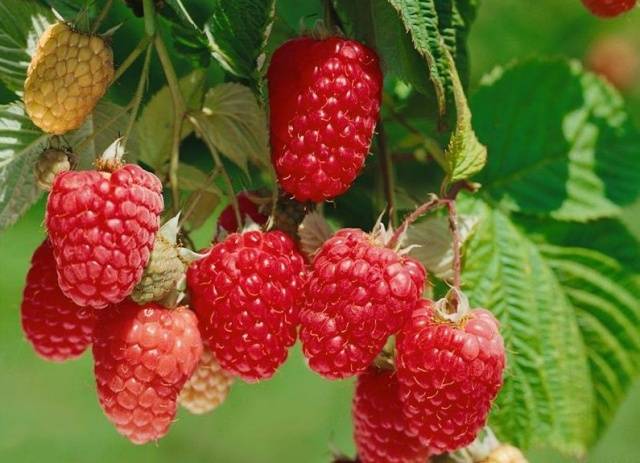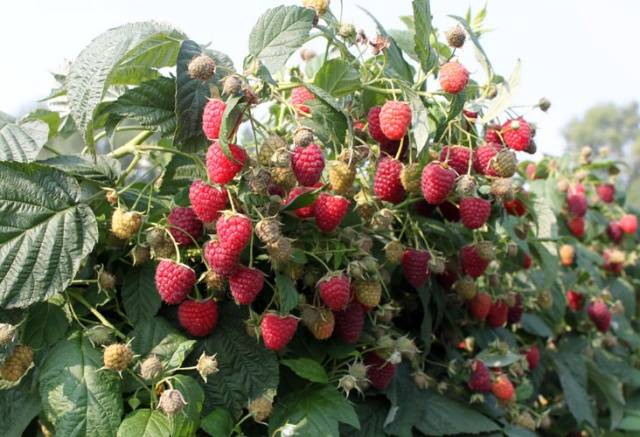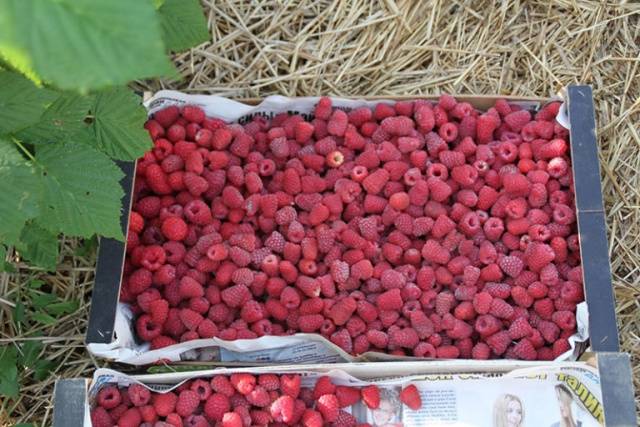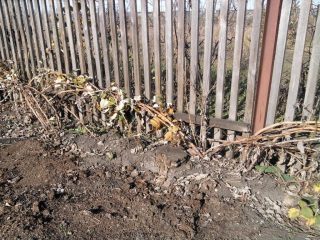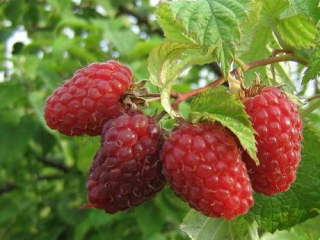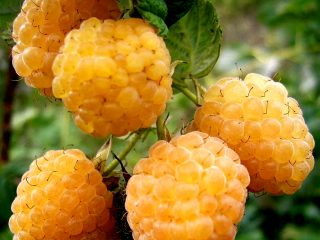Content
The Himbo Top repairing raspberry is bred in Switzerland and is used for industrial cultivation of berries and in private farms. The fruits have high external and taste qualities. The variety is suitable for growing in the middle lane; when planted in cold regions, it needs shelter for the winter.
Variety characteristic
Description of the Himbo Top raspberry variety:
- vigorous plant;
- raspberry height up to 2 m;
- powerful sprawling shoots;
- the presence of small thorns;
- length of fruit branches up to 80 cm;
- in the first year, the number of replacement shoots is 6-8, later - up to 10;
- the duration of fruiting is about 6-8 weeks.
Features of Himbo Top berries:
- bright red color, not available after ripening;
- correct elongated shape;
- large size;
- weight up to 10 g;
- good taste with slight sourness.
Fruiting of the variety begins in late July or early August. Productivity per plant - up to 3 kg. Berries do not become shallow until the end of fruiting.
It is recommended to harvest ripe fruits within 3 days to avoid shedding. With prolonged rains, raspberries acquire a watery taste.
According to the description, Himbo Top raspberries have universal application, they are eaten fresh, frozen or processed. The shelf life of harvested raspberries is limited.
Planting raspberries
The yield and taste of the crop depend on the correct choice of a place for a raspberry plant. Raspberries are planted in a lighted area with fertile soil. Healthy seedlings are chosen for planting.
Site preparation
Raspberries prefer loamy soils that are rich in nutrients. Dolomite or limestone is added to the acidic soil before planting. Raspberry trees are not made on steep slopes and in lowlands, where moisture accumulates. It is best to choose a location on a hill or with a slight incline.
The site should not be exposed to wind. Repaired raspberries produce high yields in good natural light. It is allowed to grow a crop in partial shade. In the absence of sunlight, the productivity of plants is lost, the berries acquire a sour taste.
Raspberries are not planted after tomatoes, potatoes and peppers. Crops have germinating diseases, with continuous cultivation, soil depletion occurs. Re-planting of raspberries is possible in 5-7 years.
Work order
For planting, take healthy Himbo Top raspberry seedlings with a developed root system. The height of the plant is up to 25 cm, the diameter of the shoots is about 5 cm. When self-propagating, side shoots are used, which must be separated from the mother bush and rooted.
Raspberries are planted in spring or autumn. The sequence of actions does not depend on the season. A bed for plants is prepared in advance by digging up the earth and introducing 2 buckets of humus per 1 sq. m.
Raspberry planting order:
- Dig holes measuring 40x40 cm to a depth of 50 cm.Leave 70 cm between them.
- Place the seedling in a growth stimulant solution for a day.
- Pour fertile soil into the planting hole to form a hill.
- Place the raspberry sapling on a hill, cover the roots with earth. Do not deepen the root collar.
- Compact the soil and water the plant abundantly.
After planting, care for Himbo Top with regular watering. The soil must remain moist.If the soil dries out quickly, mulch it with humus or peat.
Variety care
Repaired raspberry varieties are demanding to care for. Plants need frequent watering, top dressing and timely pruning remontant raspberries in the fall and in the spring. In cold climates, the bushes are mulched with dry leaves and covered with agrofibre to prevent raspberries from freezing.
Watering
In the absence of precipitation, Himbo Top raspberries are watered every week with warm water. The soil under the plants should be 30 cm wet.After adding moisture, the soil is loosened and weeds.
Watering is especially important during flowering and berry formation. With a lack of moisture in the plants, the ovaries fall off, and the yield decreases.
Excess moisture is also detrimental to raspberries. The root system of plants does not get access to oxygen, which impairs the absorption of nutrients. With high humidity, there is a high risk of developing fungal diseases.
In the fall, the last winter watering of raspberries is performed. The presence of moisture will allow the plants to prepare for winter.
Top dressing
Raspberry Himbo Top responds positively to fertilization. When grown in fertile areas, raspberries are fed from the third year after planting.
For the variety, both mineral dressings and the use of organic matter are suitable. It is better to alternate treatments with an interval of 2-3 weeks.
In the spring, nitrogen fertilizers are applied, which allow the plants to increase the green mass. The use of nitrogen must be abandoned during flowering and ripening of fruits.
Ways of spring feeding Himbo Top raspberries:
- fermented mullein infusion 1:15;
- infusion of nettle diluted with water 1:10;
- ammonium nitrate in the amount of 20 g per 1 sq. m.
In the summer, raspberries are fed with substances containing potassium and phosphorus. For 10 liters of water, 30 g of superphosphate and potassium sulfate are required. The solution is poured over the plants under the root.
From folk remedies for raspberries, dolomite flour or wood ash is used. Fertilizers are embedded in the soil when loosening.
Tying
According to the description of the variety and the photo, the Himbo Top raspberry grows up to 2 m.Under the weight of the berries, the shoots lean to the ground. Plants are tied to a trellis or separate supports.
At the edges of the site, posts are driven in, between which a wire or rope is pulled at a height of 60 and 120 cm from the ground. The branches are arranged in a fan-like manner. If necessary, the number of plant supports is increased.
Pruning
In the fall, it is recommended to cut remontant raspberries at the root. Branches with a length of 20-25 cm are left above the surface of the earth. Next year, new shoots will appear that will bring a crop.
If you do not cut the raspberries, then in the spring you need to eliminate frozen and dry branches. If part of the plant is frozen, then the shoots are shortened to healthy buds.
In summer, the Himbo Top variety is eliminated by excess growth. For each raspberry bush, 5-7 shoots are enough. The shoots can be used for reproduction. To do this, it is separated from the original bush and rooted in the garden. After the formation of the root system, the plants are transferred to a permanent place.
Diseases and pests
Raspberry Himbo Top is resistant to fungal diseases affecting the root system. The development of diseases occurs with high humidity, lack of care, high planting density.
Fungal diseases appear as brown spots on the stems and leaves of raspberries. In the presence of symptoms, the plants are sprayed with Bordeaux liquid, solutions of Topaz, Fitosporin, Oxyhom.
The most dangerous pests for raspberries are spider mites, aphids, beetles, caterpillars, leafhoppers, gall midges. Before flowering, plants are treated with Iskra, Karate, Karbofos.
During the ripening period of berries, it is better to abandon chemicals.They are replaced with folk remedies: infusions on onion peels, garlic, tobacco dust.
Gardeners reviews
Conclusion
Raspberry Himbo Top is prized for its good taste and increased yield. Among the disadvantages of the variety are average winter hardiness, the presence of thorns, and a short shelf life of berries. Plants are planted in lighted areas. Raspberry care includes watering and feeding.
